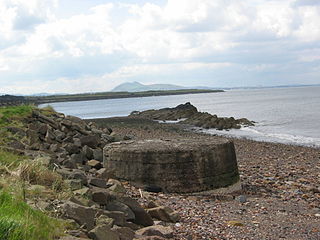Related Research Articles

Newington is a district of South London, just south of the River Thames, and part of the London Borough of Southwark. It was an ancient parish and the site of the early administration of the county of Surrey. It was the location of the County of London Sessions House from 1917, in a building now occupied by the Inner London Crown Court.
Sir Richard Maitland of Lethington and Thirlstane was a Senator of the College of Justice, an Ordinary Lord of Session from 1561 until 1584, and notable Scottish poet. He was served heir to his father, Sir William Maitland of Lethington, East Lothian, and Thirlestane, Berwickshire, on 15 October 1515, his father being one of the casualties at the Battle of Flodden. He held the political office of Keeper of the Great Seal of Scotland and was also the Keeper of the Privy Seal of Scotland, from 1563 to 1567, and was succeeded in this post by his son Sir John Maitland, 1st Lord Maitland of Thirlestane.

George Heriot was a Scottish goldsmith and philanthropist. He is chiefly remembered today as the founder of George Heriot's School, a large independent school in Edinburgh; his name has also been given to Heriot-Watt University, as well as several streets in the same city.

George Heriot's School is a Scottish private primary and secondary day school on Lauriston Place in the Old Town of Edinburgh, Scotland. In the early 21st century, it has more than 1600 pupils, 155 teaching staff, and 80 non-teaching staff. It was established in 1628 as George Heriot's Hospital, by bequest of the royal goldsmith George Heriot, and opened in 1659. It is governed by George Heriot's Trust, a Scottish charity.

George Home, 1st Earl of Dunbar, KG, PC was, in the last decade of his life, the most prominent and most influential Scotsman in England. His work lay in the King's Household and in the control of the State Affairs of Scotland and he was the King's chief Scottish advisor. With the full backing and trust of King James he travelled regularly from London to Edinburgh via Berwick-upon-Tweed.

Sir Archibald Acheson of Glencairn, Lord Glencairn, 1st Baronet, was a Scottish jurist.
Henry Charteris the younger (1565–1628) was a Scottish minister and Principal of the University of Edinburgh from 1599 to 1620.

William Wallace was a Scottish master mason and architect. He served as King's Master Mason under James VI.
Humble Ward, 1st Baron Ward, of Birmingham was the son and heir of William Ward, a London goldsmith. He married Frances Sutton otherwise Dudley, 6th Baroness Dudley, granddaughter and sole heir of Edward Sutton, 5th Baron Dudley, whose estates including Dudley Castle and Himley Hall were settled on them on 17 February 1628, at their marriage. William Ward used his wealth to buy out Lord Dudley's debts, thereby rescuing what was left of the Dudley estate from Dudley's creditors.
Frances Ward, 6th Baroness Dudley (1611-1697) succeeded to the Barony of Dudley in 1643 following the death of Edward Sutton, 5th Baron Dudley. She had married Humble Ward, the son of a London goldsmith in 1628. Humble Ward was awarded the title of Baron Ward of Birmingham and the couple's descendants carried both titles until the middle of the eighteenth century. Frances died in 1697.

Morrison's Haven is a harbour at Prestongrange, East Lothian, Scotland, UK, on the B1348, close to Levenhall Links, Prestongrange Industrial Heritage Museum, Prestonpans, and Prestongrange House.
Sir John Preston, Lord Fentonbarns, of Penicuik, was a Scottish lawyer and judge who became lord president of the court of session.
Margaret Hartsyde or Hairtsyde was a Scottish servant, jewel thief, and landowner. A servant of the queen, Anne of Denmark, Hartsyde's duties included looking after the queen's jewels, dealing with the goldsmith George Heriot, and handling large sums of money.
Sir Edward Zouch of Woking was a courtier to English kings James and Charles I, a masque actor, and Knight Marshal of the King's Household.
Elizabeth Roper was a member of the household of Anne of Denmark. She married Robert Mansell, a glass-making entrepreneur and became involved in his business. She was noted for her business activities as a "capitalist" by the historian Alice Clark.
Robert Jousie was a Scottish textile merchant, financier, and courtier. He was involved in the collection and administration of the English subsidy of James VI.
Sir William Livingstone of Kilsyth was a Scottish landowner and courtier.

The jewels of Anne of Denmark (1572–1619), wife of James VI and I and queen consort of Scotland and England, are known from accounts and inventories, and their depiction in portraits by artists including Paul van Somer. A few pieces survive. Some modern historians prefer the name "Anna" to "Anne", following the spelling of numerous examples of her signature.
Sir Ferdinando Sutton (1588-1621) was an English aristocrat.
References
- ↑ Jill Turnbull, Scottish Glass Industry 1610-1750: To Serve the Whole Nation with Glass (Edinburgh, 2001), p. 75.
- ↑ John Bruce, Calendar State Papers Domestic, 1627-1628 (London, 1858), p. 465.
- ↑ Jill Turnbull, Scottish Glass Industry 1610-1750: To Serve the Whole Nation with Glass (Edinburgh, 2001), pp. 75-6.
- ↑ Mary Anne Everett Green, Calendar State Papers Domestic, 1619-1623 (London, 1858), pp. 114-5.
- ↑ Jill Turnbull, Scottish Glass Industry 1610-1750: To Serve the Whole Nation with Glass (Edinburgh, 2001), p. 75.
- ↑ Jeremy Boulton, Neighbourhood and Society: A London Suburb in the Seventeenth Century (Cambridge, 1987), p. 150.
- ↑ Collections for a History of Staffordshire, vol. 9 (London, 1888), p. 115: William Thompson, History and Antiquities of the Collegiate Church of St Saviour, Southwark (London, 1894), pp. 42-3, 98, 146.
- ↑ Egerton Brydges, Memoirs of the Peers of England, 1 (London, 1802), p. 138: Dugdale, II, p. 217.